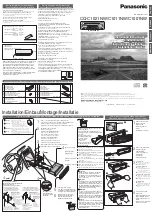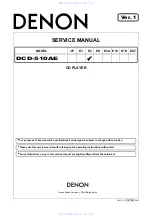
7
Original instructions
EN
WARNING:
The planer is designed so that the
blades are correctly aligned if placed flush into the bar-
rel slots and tightened correctly. When inserting new
blades it is essential that they sit square in their slot,
that they are fully inserted and that the cutting edges
are absolutely level, i.e. parallel to the surface of the
rear base. Only when all these conditions are satisfied
should the clamping bolts be tightened. If the blades
protrude or are not square, they could hit the casing
with serious risk to the operator and others in the vicin-
ity. Blade must be positioned centrally on the barrel.
NOTE:
Your planing surface will end up rough and un-
even unless the blades are set and secured properly.
The examples show proper and improper settings:
▪
Clean smooth cut:
(Fig.3)
▪
Nicks in surface
– as caused by the edge of one or
both blades not being parallel to the rear base line.
(Fig.4)
▪
Gouging at start
– as caused by the edge of one or
both blades not protruding enough in relation to the
rear base line.
(Fig.5)
▪
Gouging at end
– as caused by the edge of one or
both blades protruding too far in relation to the rear
base line.
(Fig.6)
NOTE:
(a) front base (movable shoe)
(b) rear base (stationary shoe)
WARNING:
The two red painted Allen screws
are secured with adhesive, they must not be adjusted.
The position of these screws may be altered by the
manufacturer only!
SWITCHING ON AND OFF
WARNING:
Before plugging the machine into
the power point always check that the trigger switch (9)
and lock-off button (8) work properly. Before switching
on ensure that the blade barrel is not in contact with any
surface.
1. Plug in the machine, push in the lock-off button (8) and
pull the trigger switch (9).
(Fig.8)
2. To stop the tool, simply release the trigger switch (9).
3. In order to restart the machine, it is necessary to oper-
ate both the lock-off button (8) and the trigger switch
(9). This is an important safety feature that helps pre-
vent accidental operation of the planer.
(Fig.9)
WARNING:
Please note that that the planer
blades continue to spin for some time after switch-
ing off the planer. Wait until the motor has completely
stopped before setting down the tool to prevent dam-
age to the planer blades or the surface.
4. When putting the planer down, first switch it off and
rest it on the foot (18) so that the blades do not touch
any surface.
PLANING
1. Rest the front base (3) flat on the workpiece surface
without the blades making any contact with the work-
piece.
2. Switch on the tool and wait for the blades to reach full
speed.
3. Guide the machine carefully forward, initially apply-
ing pressure on the front of the planer, holding it by
the front handle (5) Towards the end of the planning
stroke apply pressure to the rear side of the planer,
pushing on the main handle (7).
4. Push the planer beyond the edge of the workpiece
without tilting it downwards.
5. The rate of planing and the depth of cut determine
the quality of the finish. For rough cutting, you can
increase the depth of cut, however to achieve a good
finish you will need to reduce the depth of cut and ad-
vance the tool more slowly.
NOTE:
Planing is easier if you incline the workpiece
slightly away from you so that you plane “downhill”.
WARNING:
Moving the machine too fast may
cause a poor quality of cut and can damage the blades
or the motor. Moving the machine too slowly may burn
or mar the cut.
The proper feed rate will depend on the type of material
being cut and the depth of the cut.
Practice first on a scrap piece of material to gauge the
correct feed rate and the cut dimensions.
WARNING:
Clamp the workpiece to the
bench.
CHAMFERING (FIG. 10)
The V-grooves in the front base (3) allow quick and easy
chamfering of workpiece edges. Depending on the re-
quired chamfered width, place the planer with the cor-
responding V-groove onto the edge of the workpiece and
guide along the edge.
PARALLEL FENCE GUIDE
WARNING:
Always ensure that the tool is
switched off and unplugged from the power supply
before making adjustments, installing or removing
blades.
1. Centre the opening of the parallel fence (1) to the
mounting opening in the planer body.
2. Place the wing knob (2) for attaching the parallel fence
and tighten it firmly.
3. Loosen the screw on the slider, set the desired plan-
ning width and re-tighten the screw.
4. To refine planning width, use the planer on a scrap
pages-P 3110.indd 7
7.8.2012 г. 08:47:45 ч.
Содержание P 3110
Страница 2: ...1 2 3 9 4 5 7 8 10 6 4 6 2 3 7 1 14 8 5 9 10 11 12 13 17 15 16 18 ...
Страница 94: ...1203R01 ...










































